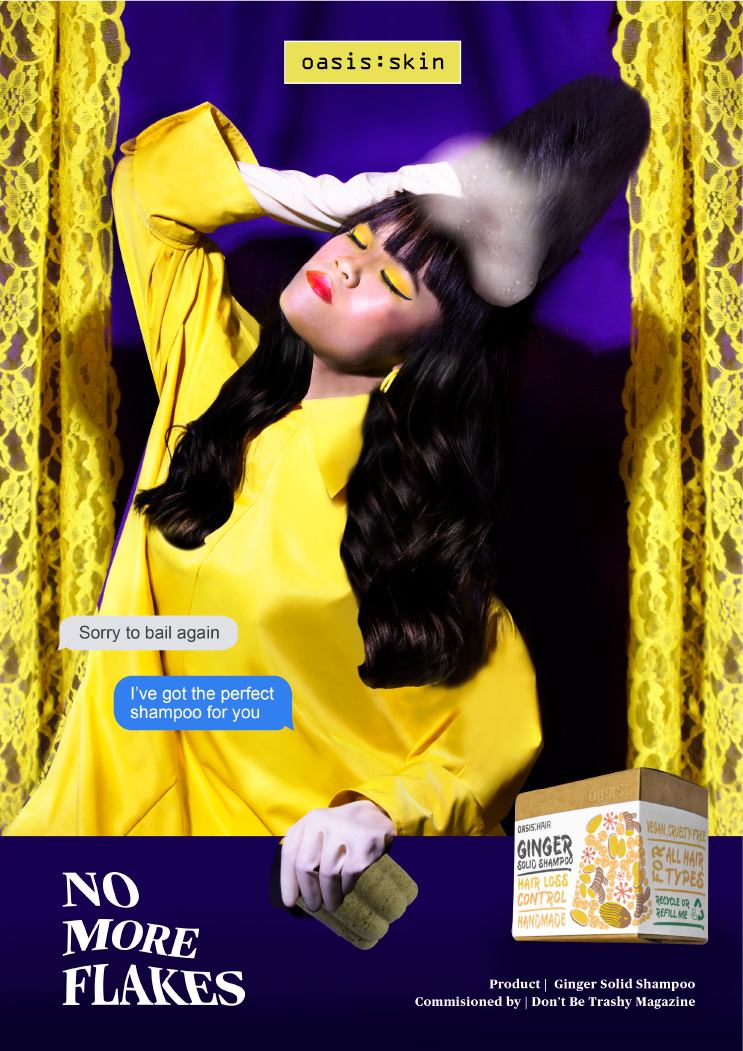




Don’t Be Trashy is an online magazine that explores the environmental discourse through the use of humour in Art, Fashion and Advertising media.
As a way to influence sustainable lifestyles, the zine introduces sustainability through the use of humour semantics and collage style art. The zine will also follow a trashy, quirky and inquisitive visual language through a fashion forward lens, creating commercial style imagery. The use of commercial style media breaks down the barriers of traditional advertising while exploring the relationship between environmentalism and visual humour. Through surreal humour where absurdity and incongruity comes to play between subjects and objects, the viewer is able to decode visual metaphors to uncover its green meaning.






Structured around the brand’s line of hair care products, the campaign emphasises its product’s benefits (Detox, Less Flakes, Hair strength) through the playful use of humour and irony. The campaign casually provides solutions for everyday difficult situations, for example, getting the viewer to “rid flakey friends” by using Oasis’ flake free shampoo. The light-hearted mockery reflects oasis’ aim to be simple, fuss-free and created with all natural (vegan) ingredients. Simple solutions, sticky situations!






The campaign is designed to command attention, through humorously depicted imagery, bold text and striking colours no less. Noting that the pieces are made from ECONYL, (fabric regenerated from fishing nets and plastic waste) - the campaign light-heartedly pushes the tension of what ECONYL is able to do for its wearer. An example of one focuses on how the pieces are able to fit like second skin, and allow one to “Not feel like a fish out of water : (and instead feel comfortable)”. This context is taken to a direct translation of a subject easing into a piece of fishing net, visually expressing that the subject is at ease. This also takes a jab at the issue of marine conservation - in an obvious yet satirical telling of marine life trapped in fishing nets- an all too glaring issue yet to be largely addressed.The campaign makes for simplistic, bold and striking ads, in a bid to allow consumers to visually articulate the value of ECONYL fabric properties for the brand OUTFYT.


Earth’s climate is now changing faster than at any point in the history of modern civilisation, primarily as a result of human activities. Global climate change has already resulted in a wide range of impacts across every region of the country and many sectors of the economy that are expected to grow in the coming decades. – Global Change

While tackling global climate change and reducingcarbon emissions will require a collaborative effort from national governmentsand businesses, sustained action by individuals and households also has a keyrole to play. But where should you start? If you want to contribute to reducingcarbon emissions, starting with your own carbon footprint (the carbon emissionsthat are the result of your lifestyle and actions), what will have the mostimpact? - Smithers
While tackling global climate change and reducing carbon emissions will require a collaborative effort from national governments and businesses, sustained action by individuals and households also has a key role to play. But where should you start? If you want to contribute to reducing carbon emissions, starting with your own carbon footprint (the carbon emissions that are the result of your lifestyle and actions), what will have the most impact? - Smithers
Microplastics are small plastic pieces less than five millimetres long which can be harmful to our ocean and aquatic life. Microplastics come from a variety of sources, including from larger plastic debris that degrades into smaller and smaller pieces. Experiments show that microplastics damage aquatic creatures, as well as turtles and birds: They block digestive tracts, diminish the urge to eat, and alter feeding behaviours, all of which reduce growth and reproductive output. Their stomachs stuffed with plastic, some species starve and die.

The rise of consumerism has had a detrimental impact on the planet. For example, clothes and apparel from the fashion and textiles industries are made using extensive amounts of water, energy, chemicals and raw materials , all of which place heavy demands on Earth's natural resources. Increasing consumerism may also result in "a shift away from values of community, spirituality, and integrity, and toward competition, materialism and disconnection".


Individual behaviours may only reduce global carbon emissions by a tiny amount — but when it comes to your role in the climate emergency, you simply can’t view your actions in a vacuum. The influence your behaviour has on the people around you is just as important as the behaviours itself. Collectively, we all have a larger role at work when it comes to practicing sustainable habits and building a more eco-friendly lifestyle. Let’s put the trash in its place (;!